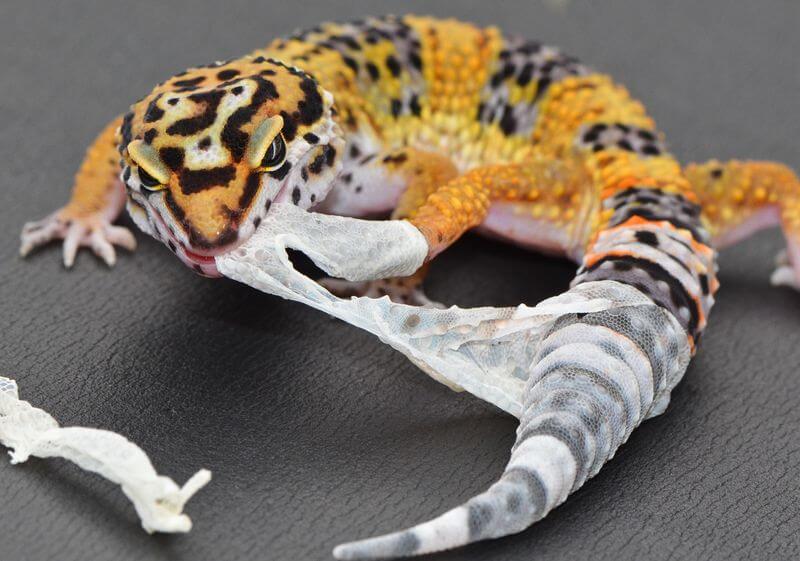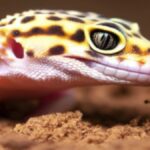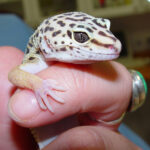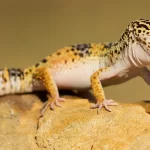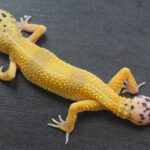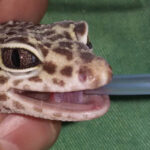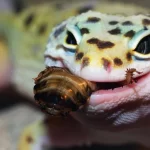Leopard geckos shed the outer parts of their skin as they grow. Skin shedding happens from time to time and is more frequently seen in babies and juveniles.
Introduction to skin shedding in Leopard geckos
For reptiles, shedding the outer parts of their skins are normal(54). Initially, the skin will turn white to grey (dull(57)) after which pieces will start to become loose and peel off. Having eyelids, the skin covering the eyes does not typically turn dull. The old skin often comes off as one complete piece, leaving a new, larger, and brighter layer of skin behind.
Shedding in reptiles functions as the replacement of old, worn skin and helps to get rid of external parasites (mites and ticks)(54). The skin shedding process is also called ecdysis(54), moulting(54) or sloughing and the sloughed skin can also be referred to as the slough(54).
Skin shedding is a physiological process where the old skin is removed to give way for a newer, usually larger one. It is controlled by the thyroid gland(54). Reptile skin consists of multiple layers and it is only the outer, dry part of the skin (called the superficial epidermis or cornified layer) that gets moulted.
Before the old layer is moulted, a new layer is already formed underneath. When its time to shed, fluid, lymph, red blood cells and enzymes are secreted that encourage separation of the outermost layer from the, still growing, inner layers(54).
Skin shedding in Leopard geckos
Unlike some other, shorter lizards(54), Leopard geckos will often shed their skin in one complete piece(54). Shedding can also happen in a couple of large pieces. The old skin breaks near the mouth and in many cases, the cast skin peels backwards over the body from head to tail. The active skin shedding process will take place over a short period of time (usually one to two hours in Leopard geckos(32)).
Often, old skin is eaten by the Leopard gecko(32)(59)(62) and shedding will take place at night — thus the process is easily missed(30).
An adult Leopard gecko in the process of shedding its skin, and eating it. In this case, the skin is actively peeled off by biting and pulling on the old skin using its mouth. Image NATURE CLIPS (CC BY YouTube)
Frequency pf skin shedding and growth rate
Baby and juvenile Leopard geckos grow faster meaning they will shed their skins more frequently than adults — typically every 10(32) to 14 days. The growth rate will depend on factors such as the amount of food given, the environmental temperature, health status and the genes of the Leopard gecko.
Adult Leopard geckos will shed approximately every 4 to 8(32) weeks. Skin shedding is often an indication that a Leopard gecko is healthy and growing. Pet Leopard geckos tend to shed more often than wild Leopard geckos.
Other than the growth rate, the frequency of skin sloughing also depends on factors such as the season, hibernation (brumation), mating(54). The state of nutrition, reproductive status, parasite load, hormonal balance, infection with bacterial or other skin pathogens, ambient temperature, and humidity may also have an effect on the frequency of ecdysis(55).
Owners can keep records of the patterns, frequencies and durations of a Leopard gecko’s skin sheddings. Records will help to predict the frequency of sheddings and can be used to monitor for abnormalities.
Also see
What to look for in a healthy Leopard gecko
Correct humidity for pet Leopard geckos
While shedding, Leopard geckos will often change their behaviour. Normal behavioural changes before, during and after the shedding process include:
During shedding, Leopard geckos are often seen rubbing their face and body against the sides of the enclosure, enclosure furniture and the floor. Some will also be seen biting at their legs and at loose pieces of skin.
To what is believed to aid in the shedding process, Leopard geckos will often be seen eating their sheds(32)(59).
During the shedding process, Leopard geckos will often rub against rough surfaces of the terrarium. This is to start the shedding process by creating ‘peeling areas’. Image Lalji Shiyani (CC BY YouTube)
During the shedding process, Leopard geckos may spend more time in their humidifying shelters hiding away or moving to safe places. It is not uncommon for Leopard geckos to refuse to eat or eat less before and during the shedding process(54).
Anorexia (unwillingness to eat) might even start days before the old skin is to be shed(54). This is likely due to the sensitivity of the new/fresh skin and the restricting nature of the old skin — making it more difficult to move around.
Leopard geckos might also be seen soaking in their water dishes during the shedding process — especially when it is problematic. By keeping the old skin moist, it will separate more easily from the body.
Also see
Leopard gecko soaking — warning signs
Skin eating behaviour in Leopard geckos
Helping Leopard geckos during skin shedding
For pet Leopard geckos, skin shedding comes with a lot of potential problems and challenges. Skin shedding problems in Leopard geckos (dysecdysis) are frequently seen.
Major contributing factors include a too low environmental humidity(54), low temperatures, improper nutrition and insufficient enclosure furniture for rubbing(55). One of the most important things that will aid in normal skin shedding in Leopard geckos is the supply of a humidifying shelter (hide box containing a moist substrate).
A correctly set up hide box will most often be enough to supply all the required humidity and will also double as a place to hide during this fragile period. Popular hide box substrates include peat/sphagnum moss(34) and vermiculite(30) that is wetted with an equal amount of water. Sprayed paper towel can also be used. The substrate should not be soggy wet but feel moist by touching it.
Other than supplying a humidifying shelter, other quick ways to increase the environmental humidity is by increasing the size of the water bowl and by misting the enclosure. Some Leopard geckos might soak more frequently in their water containers during the skin shedding process.
Twice a day misting (i.e. spraying) with lukewarm water will aid in increasing the overall environmental humidity during this period. The temperature of the spraying water needs to be similar to that of the enclosure (i.e. 25–30 ºC / 77–86 ºF(23), use a thermometer).
It was observed medically by some authors that severely malnourished lizards appear to have very difficult and irregular sloughs(55).
Items such as logs, rocks and pieces of dry wood can be used to create areas for rubbing.
Also see
Skin shedding problems in Leopard geckos
Leopard gecko hide areas and hide boxes
Ensuring the correct humidity for pet Leopard geckos
Suitable substrates for Leopard geckos
Handling Leopard geckos during skin shedding
Fresh skin is still fragile and more sensitive than the old one. It is therefore encouraged to keep handling to an as-needed basis while a Leopard gecko is in the process of shedding. Handling should be restricted up to a couple of days after the shedding process has finished.
Also see
Handling a Leopard gecko
Conclusion
Owners often see their Leopard geckos shedding its skin. It is normal in reptiles. While a Leopard gecko is shedding its skin, certain behaviours can be expected and there are various things owners can do to ease the process.

